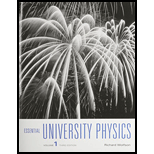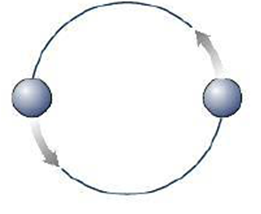
Essential University Physics (3rd Edition)
3rd Edition
ISBN: 9780134202709
Author: Richard Wolfson
Publisher: PEARSON
expand_more
expand_more
format_list_bulleted
Concept explainers
Textbook Question
Chapter 8, Problem 66P
We derived Equation 8.4 on the assumption that the massive gravitating center remains fixed. Now consider two objects with equal mass M orbiting each other, as shown in Fig. 8.18. Show that the orbital period is given by T2 = 2π2d3/GM, where d is the distance between the objects.

FIGURE 8.18 Problem 66
Expert Solution & Answer
Want to see the full answer?
Check out a sample textbook solution
Students have asked these similar questions
In the Earth-moon system, we know both bodies actually orbit around thecenter of mass of the system. Approximately where is this center of masslocated?Mearth = 5.97 x 10^24 kg
Mmoon = 1.62 x 10^23 kg
r = 382,500 km
A) Inside the earth
B) Inside the moonC) Halfway between the earth and the moon.
D) Cleveland
In the slingshot effect, the transfer of energy in an elastic collision is used to power a space probeprobe so that it can escape from the solar system. All velocity values are relative to an inertialinertial reference in which the center of the Sun remains at rest. Fig. 1(b) below shows a space probemoving at 10.4 km/s towards Saturn, which in turn is moving at 9.6 km/s towards the probe. Due todue to the gravitational force between Saturn and the probe, the probe goes around Saturn and moves in the opposite direction with speed vf .velocity vf . (a) Assuming this collision is one-dimensional and elastic, and the mass if Saturn is much greater than that of the probe, determine vfthat of the probe, determine vf . (b) By what factor does the kinetic energy increase? (c) Where does this energy come from?
What would be the minimum Earth-Moon distance at which the center-of-mass of the Earth-Moon system would lie outside the Earth’s surface?
Chapter 8 Solutions
Essential University Physics (3rd Edition)
Ch. 8.2 - Suppose the distance between two objects is cut in...Ch. 8.3 - Suppose the paths in Fig. 8.8 are the paths of...Ch. 8.4 - Prob. 8.3GICh. 8 - What do Newtons apple and the Moon have in common?Ch. 8 - Prob. 2FTDCh. 8 - When you stand on Earth, the distance between you...Ch. 8 - The force of gravity on an object is proportional...Ch. 8 - A friend who knows nothing about physics asks what...Ch. 8 - Could you put a satellite in an orbit that keeps...Ch. 8 - Why are satellites generally launched eastward and...
Ch. 8 - Given Earths mass, the Moons distance and orbital...Ch. 8 - How should a satellite be launched so that its...Ch. 8 - Does the gravitational force of the Sun do work on...Ch. 8 - Space explorers land on a planet with the same...Ch. 8 - Use data for the Moons orbit from Appendix E to...Ch. 8 - Prob. 13ECh. 8 - Prob. 14ECh. 8 - Two identical lead spheres with their centers 14...Ch. 8 - Whats the approximate value of the gravitational...Ch. 8 - A sensitive gravimeter is carried to the top of...Ch. 8 - Prob. 18ECh. 8 - Find the speed of a satellite in geostationary...Ch. 8 - Marss orbit has a diameter 1.52 times that of...Ch. 8 - Calculate the orbital period for Jupiters moon Io,...Ch. 8 - An astronaut hits a golf ball horizontally from...Ch. 8 - The Mars Reconnaissance Orbiter circles the red...Ch. 8 - Earths distance from the Sun varies from 147 Gm at...Ch. 8 - Prob. 25ECh. 8 - A rocket is launched vertically upward from Earths...Ch. 8 - What vertical launch speed is necessary to get a...Ch. 8 - Find the energy necessary to put 1 kg, initially...Ch. 8 - Whats the total mechanical energy associated with...Ch. 8 - Prob. 30ECh. 8 - Determine escape speeds from (a) Jupiters moon...Ch. 8 - Prob. 32ECh. 8 - The gravitational acceleration at a planets...Ch. 8 - One of the longest-standing athletic records is...Ch. 8 - Prob. 35PCh. 8 - If youre standing on the ground 15 m directly...Ch. 8 - Given the Moons orbital radius of 384,400 km and...Ch. 8 - Equation 7.9 relates force to the derivative of...Ch. 8 - During the Apollo Moon landings, one astronaut...Ch. 8 - Prob. 40PCh. 8 - Prob. 41PCh. 8 - Youre preparing an exhibit for the Golf Hall of...Ch. 8 - Prob. 43PCh. 8 - Satellites A and B are in circular orbits, with A...Ch. 8 - The asteroid that exploded over Chelyabinsk,...Ch. 8 - Prob. 46PCh. 8 - Prob. 47PCh. 8 - Neglecting air resistance, to what height would...Ch. 8 - Show that an object released from rest very far...Ch. 8 - Prob. 50PCh. 8 - Prob. 51PCh. 8 - Prob. 52PCh. 8 - Prob. 53PCh. 8 - Prob. 54PCh. 8 - Prob. 55PCh. 8 - Two meteoroids are 160,000 km from Earths center...Ch. 8 - Two rockets are launched from Earths surface, one...Ch. 8 - Prob. 58PCh. 8 - A missiles trajectory takes it to a maximum...Ch. 8 - Prob. 60PCh. 8 - Mercurys orbital speed varies from 38.8 km/s at...Ch. 8 - Prob. 62PCh. 8 - Two satellites are in geostationary orbit but in...Ch. 8 - Prob. 64PCh. 8 - Prob. 65PCh. 8 - We derived Equation 8.4 on the assumption that the...Ch. 8 - Prob. 67PCh. 8 - As a member of the 2040 Olympic committee, youre...Ch. 8 - The Olympic Committee is keeping you busy! Youre...Ch. 8 - Tidal forces are proportional to the variation in...Ch. 8 - Spacecraft that study the Sun are often placed at...Ch. 8 - Prob. 72PPCh. 8 - Prob. 73PPCh. 8 - Prob. 74PPCh. 8 - The Global Positioning System (GPS) uses a...
Additional Science Textbook Solutions
Find more solutions based on key concepts
The voltage across two components in series is zero. Is it possible that the voltages across the individual com...
Essential University Physics: Volume 2 (3rd Edition)
3. What is free-fall, and why does it make you weightless? Briefly describe why astronauts are weightless in th...
The Cosmic Perspective
If acceleration is proportional to the net force or is equal to net force.
Conceptual Physics (12th Edition)
Small pieces of tissue are attracted to a charged comb. Soon after stirlrinp to the comb, the pieces of tissue ...
University Physics Volume 2
23. The manufacturer of an electric table saw claims that it has a 3.0 horsepower motor. 1 horsepower is approx...
College Physics: A Strategic Approach (3rd Edition)
The pV-diagram of the Carnot cycle.
Sears And Zemansky's University Physics With Modern Physics
Knowledge Booster
Learn more about
Need a deep-dive on the concept behind this application? Look no further. Learn more about this topic, physics and related others by exploring similar questions and additional content below.Similar questions
- For many years, astronomer Percival Lowell searched for a Planet X that might explain some of the perturbations observed in the orbit of Uranus. These perturbations were later explained when the masses of the outer planets and planetoids, particularly Neptune, became better measured (Voyager 2). At the time, however, Lowell had proposed the existence of a Planet X that orbited the Sun with a mean distance of 43 AU. With what period would this Planet X orbit the Sun?arrow_forwardIn the Earth-moon system, we know both bodies actually orbit around thecenter of mass of the system. Approximately where is this center of masslocated?Mearth = 5.97 x 10^24 kg Mmoon = 1.62 x 10 23 kg r = 382,500 km A) Inside the earth B) Inside the moonC) Clevelandarrow_forwardA 1024-kg blue ball is dropped from an initial z-position of 2.3 x 106 m through the center of a planet with radius 7.6 x 106 m. If the mass of the planet is 33.9 x 1015 kg, measure the displacement of the ball at time t = 9 s?arrow_forward
- An average-sized asteroid located 5.0x107 km from the centre of the Earth with mass 2.0x1013 kg is detected headed directly toward Earth with a speed of 2.0 km/s. What will its speed before it hits the Earth's atmosphere (400 km above ground)?arrow_forwardPluto and its satellite Charon have masses which are more similar to each other than any other knonw pair of orbiting bodies in the Solar system. How far from the center of pluto is the barycenter or center of mass of the Pluto-Charon system? Take the mass of Pluto to be 1.31 × 10^22 kg, and 1.59 × 10^21 kg for Charon (about one eighth that of Pluto). Assume Pluto and its moon Charon are separated by 19,640 km while the radius of Pluto and Charon are 1190 km and that of Charon are 606 km respectively. Treating Pluto and Charon as spherically symmetric objects, how far from Pluto is the barycenter of the Pluto - Charon pair, and is this point inside are outside of Pluto? Hint: Place Pluto at the origin and Charon on the x axis. A. 289 km; inside B. 781 km; inside C. 2130 km; outside D. 5910 km; outsidearrow_forwardA group of engineers is constructing a giant, circular rotating space station. Most of the mass of the station isdistributed among three points along the outer walls of the station and separated by 120 degrees from eachother. The masses of these three points are as follows: 2500 kg, 2000.0 kg, and 1500 kg. The radius of the spacestation is 100.0 m. Find the coordinates of the center of mass (COM) of the space station.arrow_forward
arrow_back_ios
arrow_forward_ios
Recommended textbooks for you
 Physics for Scientists and Engineers: Foundations...PhysicsISBN:9781133939146Author:Katz, Debora M.Publisher:Cengage Learning
Physics for Scientists and Engineers: Foundations...PhysicsISBN:9781133939146Author:Katz, Debora M.Publisher:Cengage Learning College PhysicsPhysicsISBN:9781285737027Author:Raymond A. Serway, Chris VuillePublisher:Cengage Learning
College PhysicsPhysicsISBN:9781285737027Author:Raymond A. Serway, Chris VuillePublisher:Cengage Learning Glencoe Physics: Principles and Problems, Student...PhysicsISBN:9780078807213Author:Paul W. ZitzewitzPublisher:Glencoe/McGraw-Hill
Glencoe Physics: Principles and Problems, Student...PhysicsISBN:9780078807213Author:Paul W. ZitzewitzPublisher:Glencoe/McGraw-Hill

Physics for Scientists and Engineers: Foundations...
Physics
ISBN:9781133939146
Author:Katz, Debora M.
Publisher:Cengage Learning

College Physics
Physics
ISBN:9781285737027
Author:Raymond A. Serway, Chris Vuille
Publisher:Cengage Learning

Glencoe Physics: Principles and Problems, Student...
Physics
ISBN:9780078807213
Author:Paul W. Zitzewitz
Publisher:Glencoe/McGraw-Hill
Gravitational Force (Physics Animation); Author: EarthPen;https://www.youtube.com/watch?v=pxp1Z91S5uQ;License: Standard YouTube License, CC-BY